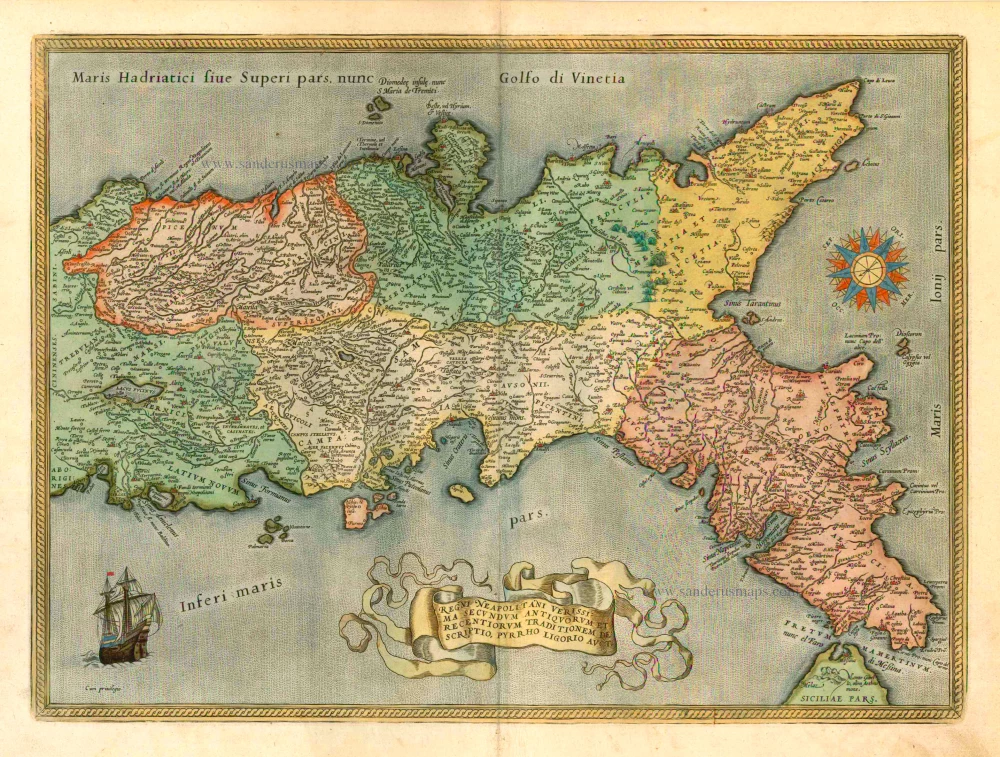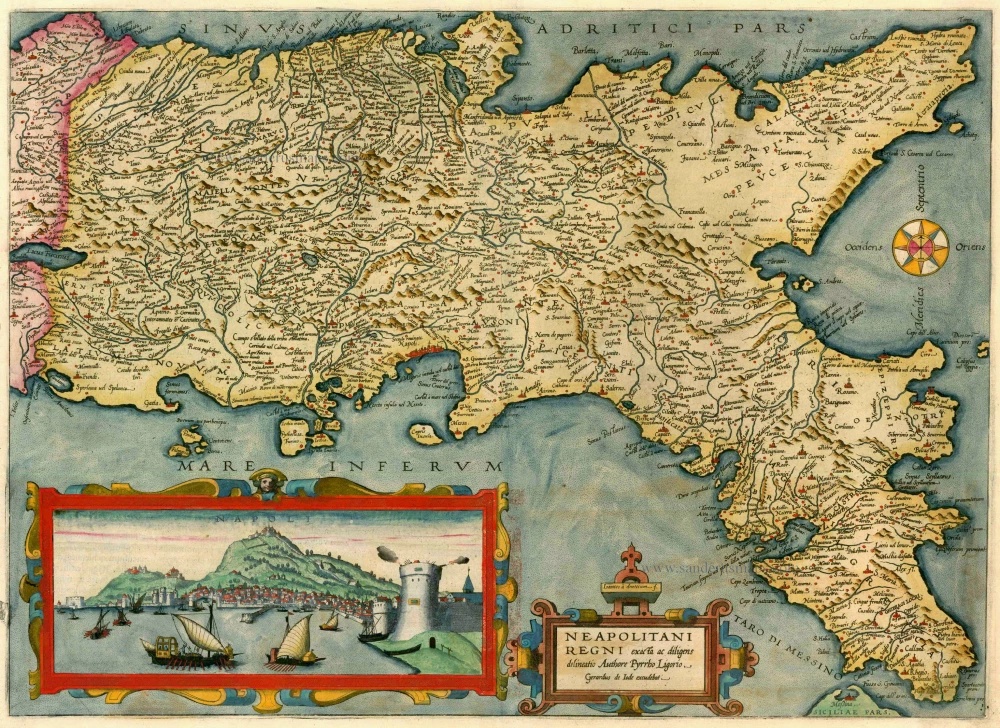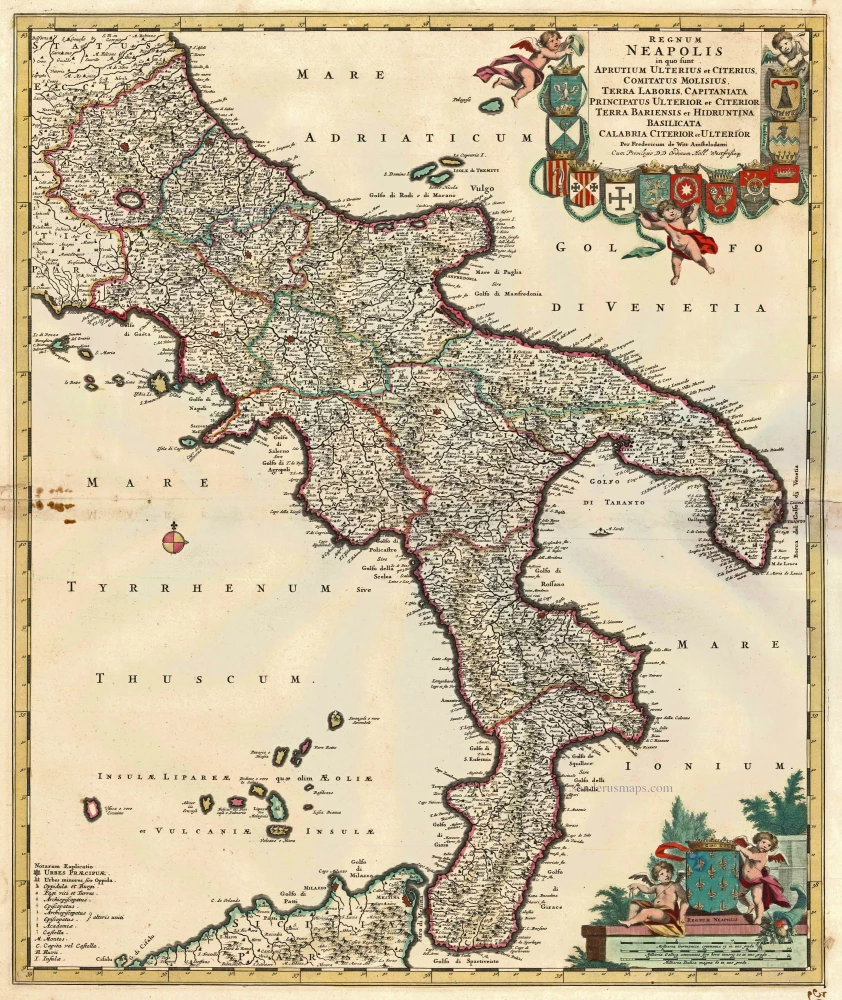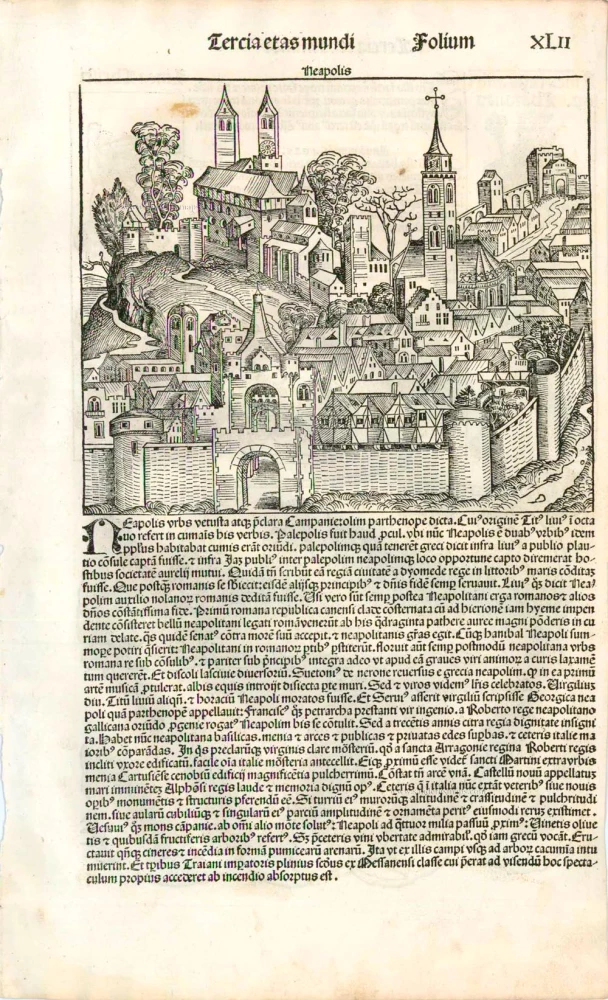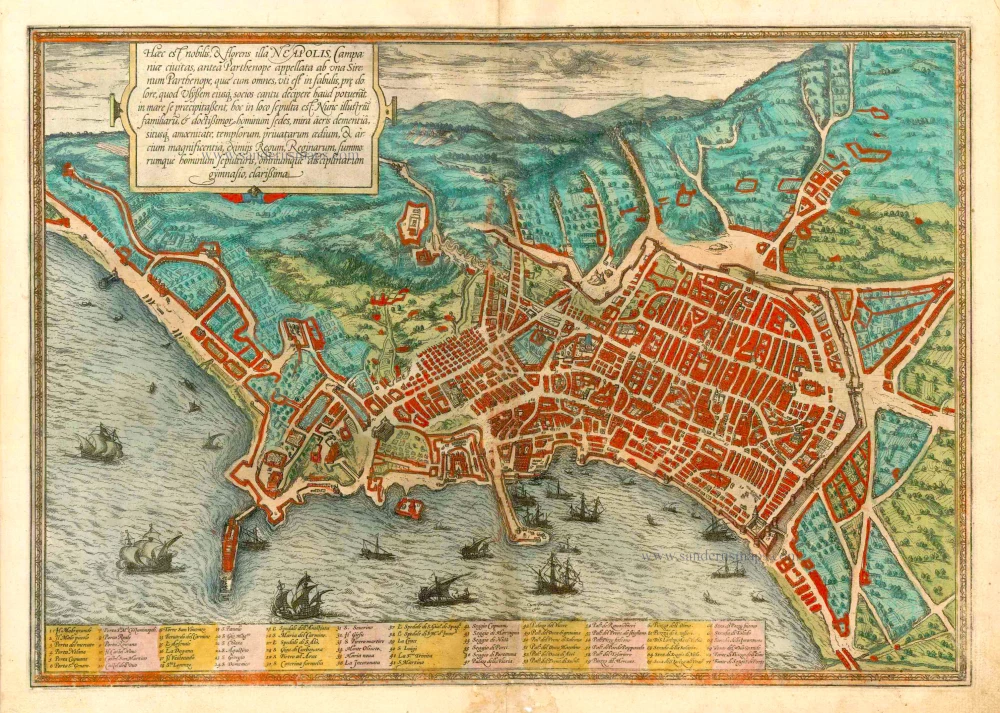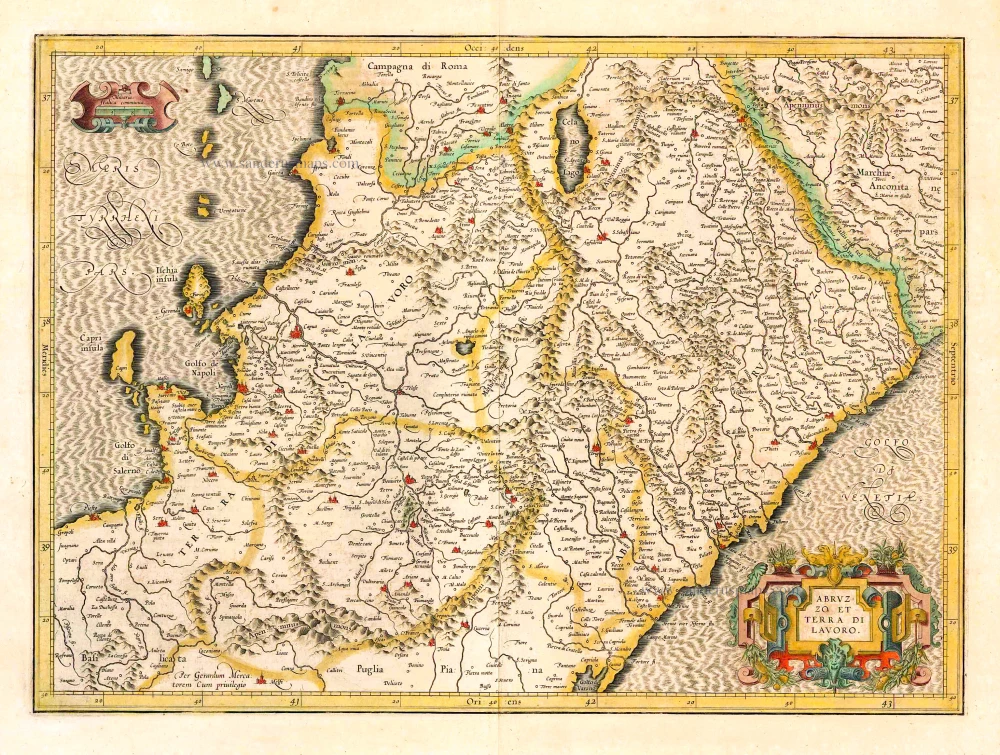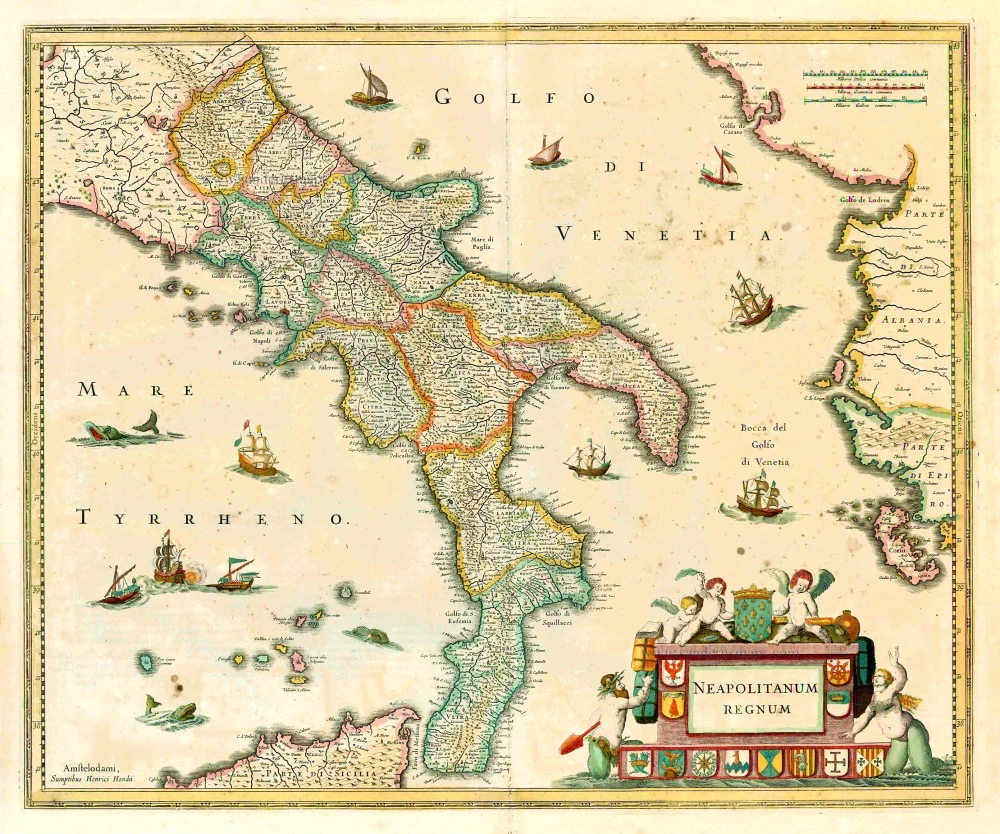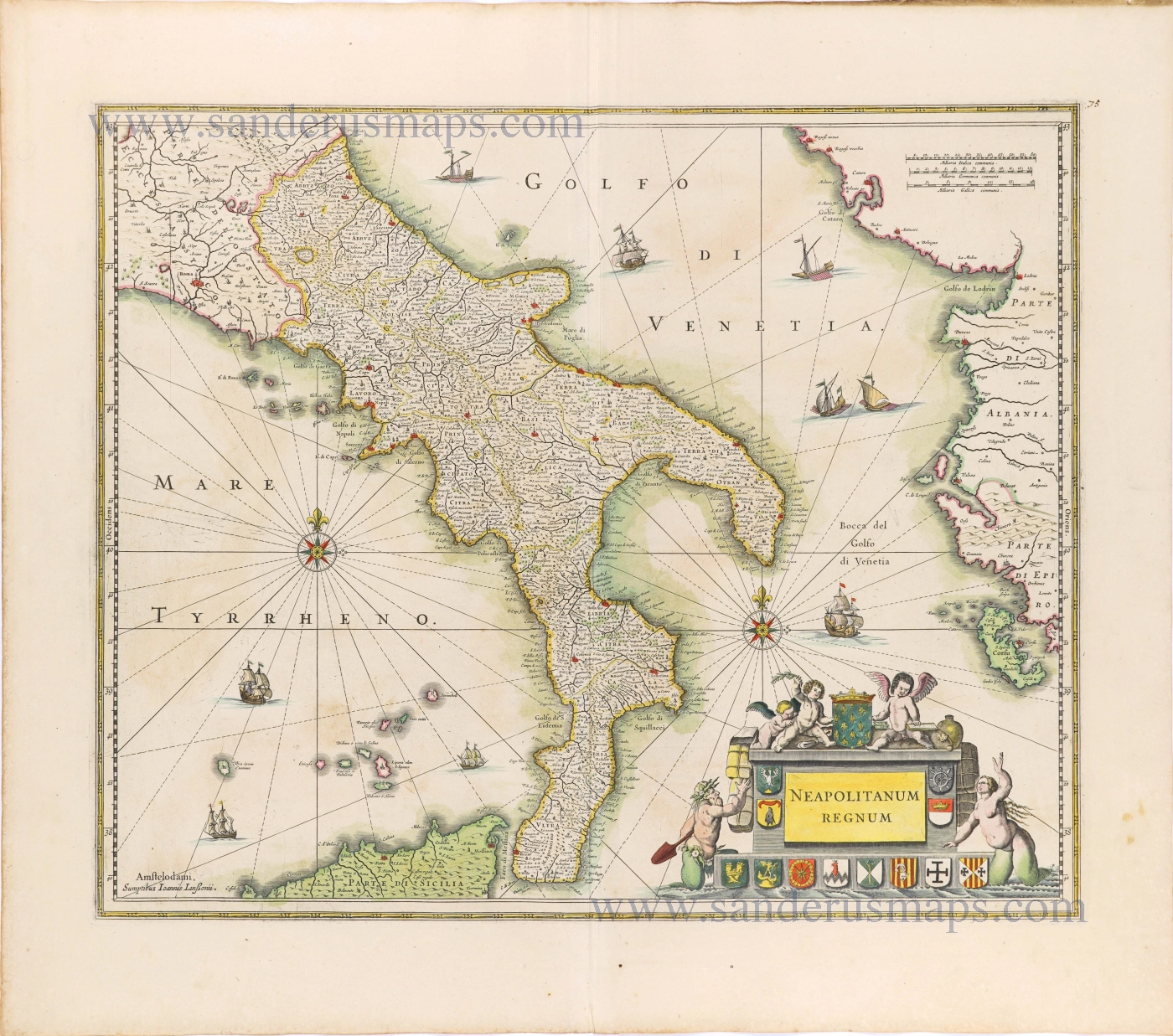ROMA by Georg Braun & Frans Hogenberg. c. 1610
TRANSLATION CARTOUCHE: This is the notable and flourishing city of Naples in Campania, formerly called Parthenope, after Parthenope the siren, who was buried in this place. As legend relates, the sirens cast themselves into the sea in fury after they had been unable to seduce Odysseus and his companions with their song. Naples, today the residence of illustrious families and most learned men, is distinguished for the wonderful mildness of its air and its delightful location, the magnificence of its churches, private houses and palaces, beautiful tombs of kings, queens and high-ranking persons, and a university with all the faculties. COMMENTARY BY BRAUN: "The fertile region around Naples [...] was the reason that the Romans liked to go to Naples after their work to rest and relax and to seek entertainment. This is where, amongst others, the most excellent poet Virgil lived, who wrote his Georgica book on agriculture here, so Servius says. Livy, Horace, Claudianus, Francesco Petrarch, Lorenzo Valla, Flavio Biondo and many others also lived here. [...] The streets are clean and straight. The strongest fortress in Naples is the Castel Nuovo, which may be rightly considered the safest castle in all Europe." Naples is presented from a plan-like bird's-eye view. The dominant impression is of a bustling city and trading port with a well-designed layout and impregnable citadel. Naples saw its greatest flowering in the early modern era under Alfonso V of Aragon, who as Alfonso I was also king of Naples and Sicily. Between 1450 and 1550 it grew from 40,000 to 210,000 inhabitants and thereby became Europe's second-largest city after Paris. Noteworthy here are the three forts: the Castel Nuovo (10) lies directly on the seafront beside the large mole. On the rocky promontory on the left, the Castel dell'Ovo (12) in the Santa Lucia district is a harbour fort from the 9th century. Looking out over the bay from above the city, lastly, is the 14th-centuy Castle Sant'Elmo (Castel S. Martino, 11), next to the Certosa di San Martino (41). (Taschen)
Braun G. & Hogenberg F. and the Civitates Orbis Terrarum.
The Civitates Orbis Terrarum, or the "Braun & Hogenberg", is a six-volume town atlas and the most excellent book of town views and plans ever published: 363 engravings, sometimes beautifully coloured. It was one of the best-selling works in the last quarter of the 16th century. Georg Braun wrote the text accompanying the plans and views on the verso. Many plates were engraved after the original drawings of a professional artist, a professional artist, Joris Hoefnagel (1542-1600). The first volume was published in Latin in 1572, and the sixth in 1617. Frans Hogenberg created the tables for volumes I through IV, and Simon van den Neuwel made those for volumes V and VI. Other contributors were cartographers Daniel Freese and Heinrich Rantzau. Works by Jacob van Deventer, Sebastian Münster, and Johannes Stumpf were also used. Translations appeared in German and French.
Following the original publication of Volume 1 of the Civitates in 1572, seven further editions of 1575, 1577, 1582, 1588, 1593, 1599 and 1612 can be identified. Vol.2, first issued in 1575, was followed by further editions in 1597 and 1612. The subsequent volumes appeared in 1581, 1588, 1593, 1599 and 1606. The German translation of the first volume appeared from 1574 on, and the French edition from 1575 on.
Several printers were involved: Theodor Graminaeus, Heinrich von Aich, Gottfried von Kempen, Johannis Sinniger, Bertram Buchholtz and Peter von Brachel, who all worked in Cologne.
Georg Braun (1541-1622)
Georg Braun was born in Cologne in 1541. After his studies in Cologne, he entered the Jesuit Order as a novice. 1561, he obtained his bachelor's degree, and in 1562, he received his Magister Artium. Although he left the Jesuit Order, he studied theology, gaining a licentiate in theology.
Frans Hogenberg (1535-1590)
Frans Hogenberg was a Flemish and German painter, engraver, and mapmaker. He was born in Mechelen as the son of Nicolaas Hogenberg.
By the end of the 1560s, Frans Hogenberg was employed upon Abraham Ortelius's Theatrum Orbis Terrarum, published in 1570; he is named an engraver of numerous maps. In 1568, he was banned from Antwerp by the Duke of Alva and travelled to London, where he stayed a few years before emigrating to Cologne. He immediately embarked on his two most important works, the Civitates, published in 1572 and the Geschichtsblätter, which appeared in several series from 1569 until about 1587.
Thanks to large-scale projects like the Geschichtsblätter and the Civitates, Hogenberg's social circumstances improved with each passing year. He died as a wealthy man in Cologne in 1590.
Roma.
Currently not available
Item Number: 26908 Authenticity Guarantee
Category: Antique maps > Europe > Italy - Cities
Antique map - bird's-eye view plan of Rome by Braun and Hogenberg, with key to locations.
COMMENTARY BY BRAUN: "The magnificent ancient ruins of the splendid buildings give a modest indication of the splendour the city formerly possessed. The Tiber flows into this city from the north and out again towards the south. But what more should I write about so famous a city, in which the successor to St Peter the Apostle and the supreme bishop of the Catholic Church has his seat, where the bones and relics of so many apostles and martyrs are to be seen?"
This engraving of Rome shows the city around 1550 in its imposing setting on seven hills, surrounded by the Aurelian Walls, 19 km long and 6 m high, dating from the 3rd century. Inside the walls on the right are the ruins of Ancient Rome with the Coliseum (37), the arch of Constantine (50), the Forum Romanum (71) and the baths of Caracalla (28) on the far right. The city centre is dominated by the best-preserved work of antique architecture, namely the Pantheon (c. AD 120). In 609, under Pope Boniface VI, the round domed structure was consecrated and dedicated to the Virgin and all the Christian martyrs, and from then on became known as Santa Maria Rotunda. Further right is the Capitoline Hill with Santa Maria in Aracoeli (99) as its summit, and to the left Trajan's column (55). On the near side of the Tiber, the Vatican (left) is dominated by Hadrian's mausoleum, the Castel Sant'Angelo, in front of which appears the old St Peter's, having undergone alterations since 1506. Work on the monumental new basilica and the layout of St Peter's square would be completed as late as the 17th century, however. In the left-hand foreground appears the Papal palace (78) and in front the obelisk (43) that comes from the circus of Caligua and Nero, in which Peter was executed. (Taschen)
Date of the first edition: 1572
Date of this map: 1599
Copper engraving
Size: 34 x 49cm (13.1 x 19 inches)
Verso text: Latin
Condition: Excellent.
Condition Rating: A
References: Taschen, Braun and Hogenberg, p.112.
From: Civitates Orbis Terrarum, Liber Primus. Köln, Bertram Buchholtz, 1599. (Van der Krogt 4, 41:1.1)
TRANSLATION CARTOUCHE: This is the notable and flourishing city of Naples in Campania, formerly called Parthenope, after Parthenope the siren, who was buried in this place. As legend relates, the sirens cast themselves into the sea in fury after they had been unable to seduce Odysseus and his companions with their song. Naples, today the residence of illustrious families and most learned men, is distinguished for the wonderful mildness of its air and its delightful location, the magnificence of its churches, private houses and palaces, beautiful tombs of kings, queens and high-ranking persons, and a university with all the faculties. COMMENTARY BY BRAUN: "The fertile region around Naples [...] was the reason that the Romans liked to go to Naples after their work to rest and relax and to seek entertainment. This is where, amongst others, the most excellent poet Virgil lived, who wrote his Georgica book on agriculture here, so Servius says. Livy, Horace, Claudianus, Francesco Petrarch, Lorenzo Valla, Flavio Biondo and many others also lived here. [...] The streets are clean and straight. The strongest fortress in Naples is the Castel Nuovo, which may be rightly considered the safest castle in all Europe." Naples is presented from a plan-like bird's-eye view. The dominant impression is of a bustling city and trading port with a well-designed layout and impregnable citadel. Naples saw its greatest flowering in the early modern era under Alfonso V of Aragon, who as Alfonso I was also king of Naples and Sicily. Between 1450 and 1550 it grew from 40,000 to 210,000 inhabitants and thereby became Europe's second-largest city after Paris. Noteworthy here are the three forts: the Castel Nuovo (10) lies directly on the seafront beside the large mole. On the rocky promontory on the left, the Castel dell'Ovo (12) in the Santa Lucia district is a harbour fort from the 9th century. Looking out over the bay from above the city, lastly, is the 14th-centuy Castle Sant'Elmo (Castel S. Martino, 11), next to the Certosa di San Martino (41). (Taschen)
Braun G. & Hogenberg F. and the Civitates Orbis Terrarum.
The Civitates Orbis Terrarum, or the "Braun & Hogenberg", is a six-volume town atlas and the most excellent book of town views and plans ever published: 363 engravings, sometimes beautifully coloured. It was one of the best-selling works in the last quarter of the 16th century. Georg Braun wrote the text accompanying the plans and views on the verso. Many plates were engraved after the original drawings of a professional artist, a professional artist, Joris Hoefnagel (1542-1600). The first volume was published in Latin in 1572, and the sixth in 1617. Frans Hogenberg created the tables for volumes I through IV, and Simon van den Neuwel made those for volumes V and VI. Other contributors were cartographers Daniel Freese and Heinrich Rantzau. Works by Jacob van Deventer, Sebastian Münster, and Johannes Stumpf were also used. Translations appeared in German and French.
Following the original publication of Volume 1 of the Civitates in 1572, seven further editions of 1575, 1577, 1582, 1588, 1593, 1599 and 1612 can be identified. Vol.2, first issued in 1575, was followed by further editions in 1597 and 1612. The subsequent volumes appeared in 1581, 1588, 1593, 1599 and 1606. The German translation of the first volume appeared from 1574 on, and the French edition from 1575 on.
Several printers were involved: Theodor Graminaeus, Heinrich von Aich, Gottfried von Kempen, Johannis Sinniger, Bertram Buchholtz and Peter von Brachel, who all worked in Cologne.
Georg Braun (1541-1622)
Georg Braun was born in Cologne in 1541. After his studies in Cologne, he entered the Jesuit Order as a novice. 1561, he obtained his bachelor's degree, and in 1562, he received his Magister Artium. Although he left the Jesuit Order, he studied theology, gaining a licentiate in theology.
Frans Hogenberg (1535-1590)
Frans Hogenberg was a Flemish and German painter, engraver, and mapmaker. He was born in Mechelen as the son of Nicolaas Hogenberg.
By the end of the 1560s, Frans Hogenberg was employed upon Abraham Ortelius's Theatrum Orbis Terrarum, published in 1570; he is named an engraver of numerous maps. In 1568, he was banned from Antwerp by the Duke of Alva and travelled to London, where he stayed a few years before emigrating to Cologne. He immediately embarked on his two most important works, the Civitates, published in 1572 and the Geschichtsblätter, which appeared in several series from 1569 until about 1587.
Thanks to large-scale projects like the Geschichtsblätter and the Civitates, Hogenberg's social circumstances improved with each passing year. He died as a wealthy man in Cologne in 1590.

